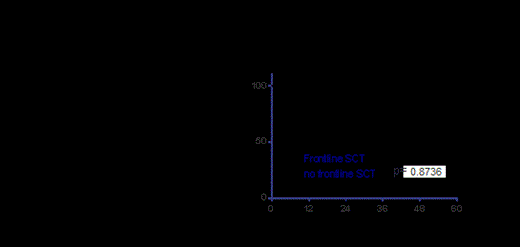Abstract
Double hit lymphoma (DHL), defined as aggressive B-cell Lymphoma with MYC and BCL2 or BCL6 rearrangement, is associated with dismal outcomes. We report our experience at MD Anderson Cancer Center over the last 15 years. This retrospective study is to serve as a historical control, and was approved by Institutional Review Board.
We reviewed medical records of patients (pts) with aggressive B-cell lymphoma diagnosed between 1998 and 2012. DHL was defined by presence of MYC gene rearrangement with IGH gene or amplification, determined by fluorescence in situ hybridization or cytogenetic analysis, in addition to similar genetic abnormality of BCL2.
We identified an initial group of 56 cases of DHL, diagnosed between 1998 and 2012. Median age was 62 years (range 18-84). Fifty pts (89%) had stage III/IV disease. Serum LDH was elevated in 37 pts (66%). IPI score was ≥3 in 42 pts (75%). Six pts (11%) had a history of low-grade lymphoma prior to the diagnosis of DHL. C-MYC rearrangement and amplification was observed in 51 (91%) and 5 (9%), respectively. BCL2 rearrangement and amplification was observed in 54 (96%) and 2 (4%), respectively. BCL6 rearrangement was tested in 9 cases, and rearrangement was observed in 2 (4%) cases (triple hit).
Initial regimens were CHOP±rituximab (R) (n=24, complete response [CR] rate 50%), hyper-CVAD alternating with methotrexate plus cytarabine ± R (n=20, CR rate 68%), EPOCH+R (n=6, CR rate 83%) and others (n=6, CR rate 50%). A total of 32 (57%) pts achieved CR. Median progression free survival duration was 9 months. Median overall survival (OS) duration was 18 months. The 3-year OS rate was 31% for all pts (Figure A), 50% for pts who achieved CR after initial therapy, and 5% for pts who did not achieve CR. Among pts who did not achieve CR, one pt is alive (4%) beyond 2.5 years after proceeding to allogeneic stem cell transplant (allo-SCT) immediately after achieving partial response to initial therapy.
In the 6 pts with early stage disease, 5 (83%) achieved CR after initial induction therapy and did not undergo frontline SCT. One of them had recurrent disease and underwent autologous SCT (auto-SCT) but died of disease. One pt who achieved only PR after initial therapy proceeded to allo-SCT, and remains in remission beyond 2.5 years after SCT. Overall, in pts with early stage disease, 3-year OS rate was 75%.
In pts with advanced stage disease (n=50), 27 (54%) pts achieved CR. Median OS duration was 13 months. 3-year OS rate was 25%, Among pts achieving CR after initial treatment (n=27), 9 underwent consolidative auto- (n=8) or allo- (n=1) SCT (median age 53, range 34-68) and 18 did not (median 61, range 18-84). Among pts undergoing frontline SCT, only 1 pt has experienced recurrence so far (4 months after auto-SCT) with a median follow up duration 17 months. However, 2 died without disease progression; one with treatment related lung toxicity (1 month post auto-SCT) and one with other comorbidities (14 months after auto-SCT). In pts achieving CR and undergoing frontline SCT, the 3-year OS rate was 66%. In pts achieving CR and not undergoing frontline SCT, the 3-year OS rate was 43%, but the difference was not statistically significant (Figure B. log-rank test 0.87, hazard ratio 0.82 for frontline SCT [95% CI 0.17-3.94, p=0.8)].
Among 10 pts who had transplant for refractory or relapsed disease (auto n=7, allo n=3), one pt who underwent allo-SCT is alive 5 years after transplant. All others (n=9) died of disease.
DHL is associated with poor outcome, except rare cases with early stage diseases. Particularly those who do not respond to initial chemotherapy have a uniformly dismal prognosis. In our limited experience, pts with recurrence typically do poorly following SCT, except rare cases of “cure” from allo-SCT. Thus, effective initial induction therapy leading to CR seems to be most effective path to the long-term survival. Consolidative frontline SCT, either autologous or allogeneic, in pts responding to the initial treatment may play a role in disease control. But in our small subset of pts, survival curve of pts undergoing frontline SCT was not significantly different from those who did not, affected by death of other cause. Further identification and analysis of additional pts with DHL is ongoing. Moreover, well designed prospective clinical trial with novel therapeutic approach is desired.

Off Label Use: sirolimus - mTOR inhibitor vorinostat - HDAC inhibitor.
Author notes
Asterisk with author names denotes non-ASH members.

This feature is available to Subscribers Only
Sign In or Create an Account Close Modal